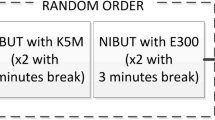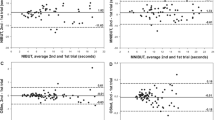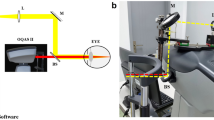Abstract
An improved continuous reading fluorophotometer with provision for controlling the blink rate has been used to measure tear turnover rates in 14 normal healthy volunteers. A significant difference between morning and afternoon tear turnover results has been found, indicating a possible circadian rhythm in tear flow. Sources of potential systematic error in the measurement method have been identified and analysed. Fluorescence measurements using a thin film cell have confirmed predictions of nonlinearity in fluorophotometer output at high tear film concentrations. The error in tear film fluorescence due to diffusion of fluorescein into the cornea has also been investigated. Simple precautions to minimise these errors are suggested, which should make the measurement method suitable for clinical application.
Similar content being viewed by others
References
Barendsen, H., Oosterhuis, J. A. andVan Haeringen, N. J. (1979) Concentration of fluorescein in tear fluid after instillation as eye drops.Ophthalmic Research,11, 73–89.
Deroetth, A. (1953) Lacrimation in normal eyes.AMA Arch. Ophthalmol.,49, 185–189.
Ehlers, N. (1965) Thickness of precorneal film.Acta Ophthalmol. Suppl.,81, Chap. 8. ‘The precorneal film’ 92–134.
Furukawa, R. E., Polse, K. A. andEmori, Y. (1976) Slit lamp fluorophotometry.Optical Eng.,15, 321–324.
Henderson, J. W. andPrough, W. A. (1950) Influence of age and sex on flow of tears.AMA Arch Ophthalmol.,43, 224–231.
Jones, D. P., Smith, A. T., Sturrock, G. D. andWright, P. (1979) Ophthalmic fluorophotometry: an improved slit-lamp fluorophotometer.Med. & Biol. Eng. & Comput.,17,3, 365–370.
Maurice, D. M. (1967) The use of fluorescein in ophthalmological research.Invest. Ophthalmol.,6, 464–477.
Mishima, S., Gasset, A., Klyce, S.D. andBaum, J. L. (1966) Determination of tear volume and flow.Invest. Ophthalmol.,5, 264–275.
Norn, M. S. (1965) Tear secretion in normal eyes.Acta Ophthalmologica,43, 567–573.
Puffer, M. J., Neault, R. W. andBrubaker, R. F. (1980) Basal precorneal tear turnover in the human eye.Amer. J. Ophthalmol.,89, 369–376.
Smith, A. T., Jones, D. P., Sturrock, G. D. andWright, P. (1977) An improved objective slit-lamp fluorophotometer using tungsten-halogen lamp excitation and synchronous detection.Br. J. Ophthalmol.,61, 722–725.
Webber, W. R. S. (1983) Fluorophotometry and the study of fluid flow in human eyes. Doctoral Thesis, University of London, UK.
Webber, W. R. S., Jones, D. P. andWright, P. (1984) Measurements of tear turnover in normal healthy persons by fluorophotometry suggest a circadian rhythm.IRCS Med. Sci.,12, 683–684.
Author information
Authors and Affiliations
Rights and permissions
About this article
Cite this article
Webber, W.R.S., Jones, D.P. Continuous fluorophotometric method of measuring tear turnover rate in humans and analysis of factors affecting accuracy. Med. Biol. Eng. Comput. 24, 386–392 (1986). https://doi.org/10.1007/BF02442693
Received:
Accepted:
Issue Date:
DOI: https://doi.org/10.1007/BF02442693




